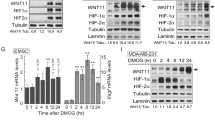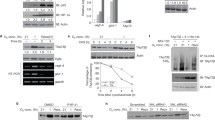Abstract
In brain, breast, and other common human tumors there is a correlation between expression of the transcriptional activator hypoxia-inducible factor 1 (HIF-1) and tumor grade and vascularization. HIF-1 stimulates angiogenesis by activating transcription of the gene encoding vascular endothelial growth factor (VEGF). HIF-1 is a heterodimer consisting of a constitutively-expressed HIF-1β subunit and an O2– and growth factor-regulated HIF-1α subunit. Recent studies have demonstrated that HIF-1α expression is increased in tumor relative to normal tissue by two mechanisms. First, decreased intratumoral O2 concentrations provide a physiological stimulus. Second, genetic alterations that activate oncogene products or inactivate tumor suppressor gene products increase HIF-1α expression and/or HIF-1 transcriptional activity independent of the O2 concentration. Taken together, these recent data suggest that increased HIF-1 activity provides a molecular basis for VEGF-induced angiogenesis and other adaptations of cancer cells to hypoxia that are critical for establishment of a primary tumor and its progression to the lethal phenotype.
Similar content being viewed by others
References
Hanahan D, Weinberg RA: The hallmarks of cancer. Cell 100: 57-70, 2000
Vogelstein B, Kinzler KW (eds): The Genetic Basis of Human Cancer, McGraw-Hill, New York, 1998
Yokota J: Tumor progression and metastasis. Carcinogenesis 21: 497-503, 2000
Fidler IJ, Ellis LM: The implication of angiogenesis for the biology and therapy of cancer metastasis. Cell 79: 185-188, 1994
Hanahan D, Folkman J: Patterns and emerging mechanisms of the angiogenic switch during tumorigenesis. Cell 86: 353-364, 1996
Kerbel RS: Tumor angiogenesis: past, present, and the near future. Carcinogenesis 21: 505-515, 2000
Zetter BR: Angiogenesis and tumor metastasis. Annu Rev Med 49: 407-424, 1998
Folkman J: Incipient angiogenesis. J Natl Cancer Inst 92: 94-95, 2000
Ferrara N: Molecular and biological properties of vascular endothelial growth factor. J Mol Med 77: 527-543, 1999
Semenza GL: Hypoxia, clonal selection, and the role of HIF-1 in tumor progression. Crit Rev Biochem Mol Biol 35: 71-103, 2000
Brown JM, Giaccia AJ: The unique physiology of solid tumors: opportunities (and problems) for cancer therapy. Cancer Res 58: 1408-1416, 1998
Vaupel P: Oxygen transport in tumors. Adv Exp Med Biol 388: 341-356, 1996
Yuan J, Glazer PM: Mutagenesis induced by the tumor microenvironment. Mutation Res 400: 439-446, 1998
Brizel DM, Scully SP, Harrelson JM, Layfield LJ, Bean JM, Prosnitz LR, Dewhirst MW: Tumor oxygenation predicts for the likelihood of distant metastases in human soft tissue sarcoma. Cancer Res 56: 941-943, 1996
Hockel M, Schlenger K, Aral B, Mitze M, Schaffer U, Vaupel P: Association between tumor hypoxia and malignant progression in advanced cancer of the uterine cervix. Cancer Res 56: 4509-4515, 1996
Plate KH, Breier G, Weich HA, Risau W: Vascular endothelial growth factor is a potential tumor angiogenesis factor in human gliomas in vivo. Nature 359: 845-848, 1992
Shweiki D, Itin A, Soffer D, Keshet E: Vascular endothelial growth factor induced by hypoxia may mediate hypoxia-initiated angiogenesis. Nature 359: 843-845, 1992
Stein I, Itin A, Einat P, Skaliter R, Grossman Z, Keshet E: Translation of vascular endothelial growth factor mRNA by internal ribosome entry: implications for translation under hypoxia. Mol Cell Biol 18: 3112-3119, 1998
Semenza GL: HIF-1: mediator of physiological and pathophysiological responses to hypoxia. J Appl Physiol 88: 1474-1480, 2000
Carmeliet P, Dor Y, Herbert J-M, Fukumura D, Brusselmans K, Dewerchin M, Neeman M, Bono F, Abramovitch R, Maxwell P, Koch CJ, Ratcliffe P, Moons L, Jain RK, Collen D, Keshet E: Role of HIF-1a in hypoxia-mediated apoptosis, cell proliferation, and tumour angiogenesis. Nature 394: 485-490, 1998
Ryan HE, Lo J, Johnson RS: HIF-1_ is required for solid tumor formation and embryonic vascularization. EMBO J 17: 3005-3015, 1998
Burger PC, Scheithauer BW: Tumors of the Central Nervous System, Armed Forces Institute of Pathology, Washington, 1993.
Helmlinger G, Yuan F, Dellian M, Jain RK: Interstitial pH and pO2 gradients in solid tumors in vivo: high-resolution measurements reveal a lack of correlation. Nature Med 3: 177-182, 1997
Zagzag D, Zhong H, Scalzitti JM, Laughner E, Simons JW, Semenza GL: Expression of hypoxia-inducible factor 1α in human brain tumors: association with angiogenesis, invasion, and progression. Cancer 88: 2606-2618, 2000
Zhong H, De Marzo AM, Laughner E, Lim M, Hilton DA, Zagzag D, Buechler P, IsaacsWB, Semenza GL, Simons JW: Overexpression of hypoxia-inducible factor 1α in common human cancers and their metastases. Cancer Res 59: 5830-5835, 1999
Ravi R, Mookerjee B, Bhujwalla ZM, Sutter CH, Artemov D, Zeng Q, Dillehay LE, Madan A, Semenza GL, Bedi A: Regulation of tumor angiogenesis by p53-induced degradation of hypoxia-inducible factor 1α. Genes Dev 14: 34-44, 2000
Zhong H, Chiles K, Feldser D, Laughner E, Hanrahan C, Georgescu MM, Simons JW, Semenza GL: Modulation of HIF-1α expression by the epidermal growth factor/phosphatidylinositol 3-kinase/PTEN/AKT/FRAP pathway in human prostate cancer cells: implications for tumor angiogenesis and therapeutics. Cancer Res 60: 1541-1545, 2000
Zundel W, Schindler C, Haas-Kogan D, Koong A, Kaper F, Chen E, Gottschalk AR, Ryan HE, Johnson RS, Jefferson AB, Stokoe D, Giaccia AJ: Loss of PTEN facilitates HIF-1-mediated gene expression. Genes Dev 14: 391-396, 2000
Wizigmann-Voos S, Breier G, Risau W, Plate KH: Up-regulation of vascular endothelial growth factor and its receptors in von Hippel-Lindau disease-associated and sporadic hemangioblastomas. Cancer Res 55: 1358-1364, 1995
Kaelin Jr WG, Maher ER: TheVHLtumour-suppressor gene paradigm. Trends Genet 14: 423-426, 1998
Huang LE, Gu J, Schau M, Bunn HF: Regulation of hypoxia-inducible factor 1α is mediated by an O2-dependent degradation domain via the ubiquitin-proteasome pathway. Proc Natl Acad Sci USA 95: 7987-7992, 1998
Kallio PJ, Wilson WJ, O'Brien S, Makino Y, Poellinger L: Regulation of the hypoxia-inducible transcription factor 1α by the ubiquitin-proteasome pathway. J Biol Chem 274: 6519-6525, 1999
Salceda S, Caro J: Hypoxia-inducible factor 1α (HIF-1α) protein is rapidly degraded by the ubiquitin-proteasome system under normoxic conditions: its stabilization by hypoxia depends upon redox-induced changes. J Biol Chem 272: 22 642-22 647, 1997
Sutter CH, Laughner E, Semenza GL: HIF-1α protein expression is controlled by oxygen-regulated ubiquitination that is disrupted by deletions and missense mutations. Proc Natl Acad Sci USA 97: 4748-4753, 2000
Maxwell PH, Wiesener MS, Chang GW, Clifford SC, Vaux EC, Cockman ME, Wykoff CC, Pugh CW, Maher ER, Ratcliffe PJ: The tumor suppressor protein VHL targets hypoxia-inducible factors for oxygen-dependent proteolysis. Nature 399: 271-275, 1999
Cockman ME, Masson N, Mole DR, Jaakkola P, Chang GW, Clifford SC, Maher ER, Pugh CW, Ratcliffe PJ, Maxwell PH: Hypoxia-inducible factor-α binding and ubiquitylation by the von Hippel-Lindau tumor suppressor protein. J Biol Chem, 2000, (in press)
Levine AJ: p53, the cellular gatekeeper for growth and division. Cell 88: 323-331, 1997
Haupt Y, Maya R, Kazaz A, Oren M: Mdm2 promotes the rapid degradation of p53. Nature 387: 296-299, 1997
Kubbutat MHG, Jones SN, Vousden KH: Regulation of p53 stability by Mdm2. Nature 387: 299-303, 1997
Graeber TG, Osmanian C, Jacks T, Housman DE, Koch CJ, Lowe SW, Giaccia AJ: Hypoxia-mediated selection of cells with diminished apoptotic potential in solid tumors. Nature 379: 88-91, 1996
An W, Kanekal M, Simon MC, Maltepe E, Blagosklonny MV, Neckers LM: Stabilization of wild-type p53 by hypoxia-inducible factor 1α. Nature 392: 405-408, 1998
Dameron KM, Volpert OV, Tainsky MA, Bouck N: Control of angiogenesis in fibroblasts by p53 regulation of thrombospondin-1. Science 265: 1582-1584, 1994
Van Meir EG, Polverini PJ, Chazin VR, Huang HJS, de Tribolet N, Cavenee WK: Release of an inhibitor of angiogenesis upon induction of wild type p53 expression in glioblastoma cells. Nature Genet 8: 171-176, 1994
Feldser D, Agani F, Iyer NV, Pak B, Ferreira G, Semenza GL: Reciprocal postive regulation of hypoxia-inducible factor 1α and insulin-like growth factor 2. Cancer Res 59: 3915-3918, 1999
Zhang L, Zhou W, Velculescu VE, Kern SE, Hruban RH, Hamilton SR, Vogelstein B, Kinzler KW: Gene expression profiles in normal and cancer cells. Science 276: 1268-1272, 1997
Cantley LC, Neel BG: New insights into tumor suppression: PTEN suppresses tumor formation by restraining the phosphoinositide 3-kinase/AKT pathway. Proc Natl Acad Sci USA 96: 4240-4245, 1999
Arbiser JL, Moses MA, Fernandez CA, Ghiso N, Cao Y, Klauber N, Frank D, Brownlee M, Flynn E, Parangi S, Byers HR, Folkman J: Oncogenic H-ras stimulates tumor angiogenesis by two distinct pathways. Proc Natl Acad Sci USA 94: 861-866, 1997
Mazure NM, Chen EY, Laderoute KR, Giaccia AJ: Induction of vascular endothelial growth factor by hypoxia is modulated by a phosphatidylinositol 3-kinase/Akt signaling pathway in Ha-ras-transformed cells through a hypoxia inducible factor-1 transcriptional element. Blood 90: 3322-3331, 1997
Giri D, Ittmann M: Inactivation of the PTEN tumor suppressor gene is associated with increased angiogenesis in clinically localized prostate carcinoma. Hum Pathol 30: 419-424, 1999
Frame S, Balmain A: Integration of positive and negative growth signals during ras pathway activation in vivo. Curr Opin Genet Dev 10: 106-113, 2000
Shields JM, Pruitt K, McFall A, Shaub A, Der CJ: Understanding Ras: 'it ain't over 'til it's over'. Trends Cell Biol 10: 147-154, 2000
Rak J, Mitsuhashi Y, Bayko L, Filmus J, Shirasawa S, Sasazuki T, Kerbel RS: Mutant ras oncogenes upregulate VEGF/VPF expression: implications for induction and inhibition of tumor angiogenesis. Cancer Res 55: 4575-4580, 1995
Rak J, Mitsuhashi Y, Sheehan C, Tamir A, Viloria-Petit A, Filmus J, Mansour SJ, Ahn NG, Kerbel RS: Oncogenes and tumor angiogenesis: differential modes of vascular endothelial growth factor up-regulation in ras-transformed epithelial cells and fibroblasts. Cancer Res 60: 490-498, 2000
Richard DE, Berra E, Gothie E, Roux D, Pouyssegur J: p42/p44 mitogen-activated protein kinases phosphorylate hypoxia-inducible factor 1α (HIF-1α) and enhance the transcriptional activity of HIF-1. J Biol Chem 274: 32 631-32 637, 1999
Holland EC, Celestino J, Dai C, Schaefer L, Sawaya RE, Fuller GN: Combined activation of ras and akt in neural progenitors induces glioblastoma formation in mice. Nature Genet 25: 55-57, 2000
Penuel E, Martin GS: Transformation by v-Src: Ras-MAPK and PI3K-mTOR mediate parallel pathways. Mol Biol Cell 10: 1693-1703, 1999
Jiang B-H, Agani F, Passaniti A, Semenza GL: V-SRC induces expression of hypoxia-inducible factor 1 (HIF-1) and transcription of genes encoding vascular endothelial growth factor and enolase 1: involvement of HIF-1 in tumor progression. Cancer Res 57: 5328-5335, 1997
Irby RB, Mao W, Coppola D, Kang J, Loubeau JM, Trudeau W, Karl R, Fujita DJ, Jove R, Yeatman TJ: Activating SRC mutation in a subset of advanced human colon cancers. Nature Genet 21: 187-190, 1999
Ellis LM, Staley CA, Liu W, Fleming RY, Parikh NU, Bucana CD, Gallick GE: Down-regulation of vascular endothelial growth factor in a human colon carcinoma cell line transfected with an antisense expression vector specific for c-src. J Biol Chem 273: 1052-1057, 1998
D'Amore PA, Shima DT: Tumor angiogenesis: a physiological process or genetically determined? Cancer Metast Rev 15: 205-212, 1996
Buolamwini JK: Novel anticancer drug discovery. Curr Opin Chem Biol 3: 500-509, 1999
Cardenas ME, Sanfridson A, Cutler NS, Heitman J: Signal-transduction cascades as targets for therapeutic intervention by natural products. Trends Biotechnol 16: 427-433
Author information
Authors and Affiliations
Rights and permissions
About this article
Cite this article
Semenza, G.L. HIF-1: Using Two Hands to Flip the Angiogenic Switch. Cancer Metastasis Rev 19, 59–65 (2000). https://doi.org/10.1023/A:1026544214667
Issue Date:
DOI: https://doi.org/10.1023/A:1026544214667




